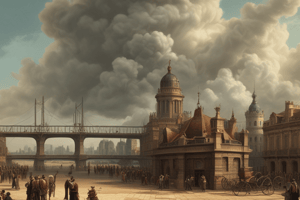Podcast
Questions and Answers
How did Roman aqueducts primarily benefit cities?
How did Roman aqueducts primarily benefit cities?
- Through the use of manual pumps to elevate water to higher elevations.
- By delivering a consistent supply of clean water utilizing gravity and precise slope management. (correct)
- By eliminating the necessity for cisterns, thus simplifying water storage solutions.
- By serving mainly as decorative features with minimal practical use.
What critical function does the crank mechanism provide that made it essential to later inventions like the steam engine?
What critical function does the crank mechanism provide that made it essential to later inventions like the steam engine?
- Preventing mechanical failures due to overheating by acting as an internal cooling system.
- Removing the requirement for wheels in various mechanical systems.
- Converting rotational motion into linear motion (or vice versa), which allows for the creation of recurring actions in machinery. (correct)
- Replacing conventional gear systems by transmitting power directly without any need for rotational movement.
How does Newton's Law of Universal Gravitation connect celestial and terrestrial phenomena?
How does Newton's Law of Universal Gravitation connect celestial and terrestrial phenomena?
- It claimed objects in motion experience no force, maintaining constant velocity in a linear path.
- It suggested differing forces govern the movement of celestial bodies versus objects in Earth's environment.
- It posited that gravity's influence is exclusive to Earth, not extending into space.
- It unified our understanding by stating that the same force causing an apple to fall also governs the orbit of planets around the Sun. (correct)
What key insight was Galileo likely aiming to demonstrate with his Leaning Tower of Pisa experiment?
What key insight was Galileo likely aiming to demonstrate with his Leaning Tower of Pisa experiment?
Which option accurately portrays the changes brought about by the Industrial Revolution?
Which option accurately portrays the changes brought about by the Industrial Revolution?
What characterized the Second Industrial Revolution regarding technological and resource advancements?
What characterized the Second Industrial Revolution regarding technological and resource advancements?
How did the organization of labor change when factories were introduced?
How did the organization of labor change when factories were introduced?
What does "Mineral-Schumpeterian growth" mean?
What does "Mineral-Schumpeterian growth" mean?
According to Henry, how did our understanding of the cosmos change between 1500 and 1700?
According to Henry, how did our understanding of the cosmos change between 1500 and 1700?
According to Mumford, what was the primary driver of industrial transformation in the 18th and 19th centuries?
According to Mumford, what was the primary driver of industrial transformation in the 18th and 19th centuries?
What mechanical concept enabled ancient odometers to reliably measure distance?
What mechanical concept enabled ancient odometers to reliably measure distance?
In the three-field system, a field was left fallow each year. What advantage did this provide over the two-field system?
In the three-field system, a field was left fallow each year. What advantage did this provide over the two-field system?
Which discovery by Galileo most directly challenged Aristotle's idea of a perfect and unchanging celestial sphere?
Which discovery by Galileo most directly challenged Aristotle's idea of a perfect and unchanging celestial sphere?
What was the key implication of Copernicus's heliocentric model for Earth's status?
What was the key implication of Copernicus's heliocentric model for Earth's status?
Which feature characterized the First Industrial Revolution (1770s-1850s)?
Which feature characterized the First Industrial Revolution (1770s-1850s)?
What is one reason historians refer to the West's rapid economic and technological expansion in the 19th century as the "Great Divergence?"
What is one reason historians refer to the West's rapid economic and technological expansion in the 19th century as the "Great Divergence?"
Which factor is NOT commonly listed among the deep determinants that fostered industrial breakthroughs in Europe?
Which factor is NOT commonly listed among the deep determinants that fostered industrial breakthroughs in Europe?
Ian Morris's index of social development includes measures of:
Ian Morris's index of social development includes measures of:
According to Henry's narrative, what was one major outcome of the Copernican Revolution?
According to Henry's narrative, what was one major outcome of the Copernican Revolution?
Which statement best reflects Mumford's view of steam power's role in paleotechnic civilization?
Which statement best reflects Mumford's view of steam power's role in paleotechnic civilization?
Flashcards
Roman Aqueducts
Roman Aqueducts
Clean water supplied to cities using gravity and managed gradients.
Crank Mechanism
Crank Mechanism
Converts rotary motion to linear motion, enabling repetitive machine actions.
Newton's Law of Universal Gravitation
Newton's Law of Universal Gravitation
The same force causing an apple to fall also keeps planets in orbit around the Sun.
Galileo's Leaning Tower of Pisa
Galileo's Leaning Tower of Pisa
Signup and view all the flashcards
The Industrial Revolution
The Industrial Revolution
Signup and view all the flashcards
Second Industrial Revolution Technologies
Second Industrial Revolution Technologies
Signup and view all the flashcards
Factories alter labor organization
Factories alter labor organization
Signup and view all the flashcards
Mineral-Schumpeterian growth
Mineral-Schumpeterian growth
Signup and view all the flashcards
Cosmological shift (1500-1700)
Cosmological shift (1500-1700)
Signup and view all the flashcards
Key factor transforming 18th- and 19th-century industry
Key factor transforming 18th- and 19th-century industry
Signup and view all the flashcards
Ancient odometers and distance
Ancient odometers and distance
Signup and view all the flashcards
Three-field system advantage
Three-field system advantage
Signup and view all the flashcards
Galileo's challenge to Aristotle
Galileo's challenge to Aristotle
Signup and view all the flashcards
Copernicus's heliocentric model implication
Copernicus's heliocentric model implication
Signup and view all the flashcards
Characteristic of the First Industrial Revolution
Characteristic of the First Industrial Revolution
Signup and view all the flashcards
The "Great Divergence"
The "Great Divergence"
Signup and view all the flashcards
Ian Morris's index of social development
Ian Morris's index of social development
Signup and view all the flashcards
Outcome of the Copernican Revolution
Outcome of the Copernican Revolution
Signup and view all the flashcards
Steam power's role in paleotechnic civilization
Steam power's role in paleotechnic civilization
Signup and view all the flashcards
Agricultural techniques not lead to a European-style industrial revolution in India and China
Agricultural techniques not lead to a European-style industrial revolution in India and China
Signup and view all the flashcards
Study Notes
Quiz 2A
- Roman aqueducts supplied cities with clean water by using gravity and carefully managed gradients.
- The crank mechanism converts rotary motion to linear motion (and vice versa), enabling repetitive machine actions.
- Newton's Law of Universal Gravitation unified motions on Earth and in the heavens by showing the same force causes an apple to fall and keeps planets in orbit.
- Galileo's Leaning Tower of Pisa demonstration was most likely a thought experiment illustrating that, in theory, different masses fall at the same rate.
- The Industrial Revolution: a constellation of new power sources, specialized equipment, and organizational changes in factories.
- During the "Second Industrial Revolution," steel, electricity, chemicals, and internal combustion engines came to prominence.
- Factories altered traditional labor organization by concentrating production in centralized locations, coordinating large numbers of workers and machines.
- "Mineral-Schumpeterian growth" refers to economies powered by inanimate energy sources (coal, oil) that encourage continuous technological innovation.
- According to Henry's account, the most significant cosmological shift that occurred between 1500 and 1700 was from a geocentric, finite cosmos of nested spheres to a heliocentric, potentially infinite universe.
- According to Mumford, the large-scale adoption of coal for power, tied to iron smelting and steam engines, fundamentally transformed 18th- and 19th-century industry.
Quiz 2B
- Ancient odometers measured distance using a calibrated wheel and gear train that counted rotations.
- The three-field system allowed two-thirds of the land to be cultivated each year instead of just half.
- Galileo's discovery of sunspots moving across the Sun's surface posed a direct challenge to Aristotle's concept of a perfect, unchanging celestial realm.
- Copernicus's heliocentric model implied that Earth was one of several planets orbiting the Sun.
- The First Industrial Revolution (1770s-1850s) was characterized by the invention of the cotton gin and spinning jenny, leading to textile mill expansion.
- The "Great Divergence" refers to Western Europe and North America surging ahead of other regions in industrial productivity in the 19th century.
- A total absence of political competition among European states is not commonly listed among the deep determinants that fostered industrial breakthroughs in Europe.
- Ian Morris's index of social development includes measures of energy capture, urbanization, information processing, and war-making capacity.
- The Copernican Revolution precipitated a profound shift in cosmology, physics, and ideas of space, ultimately leading to Newton's concept of absolute space.
- Mumford viewed that steam engines replaced other power sources and encouraged large-scale, centralized factory production in paleotechnic civilization.
Quiz 2C
- The state and social structures in India and China often absorbed or redistributed the surplus, limiting private market growth, which explains why more advanced agricultural techniques in those countries did not lead to a European-style industrial revolution.
- The crank mechanism converts rotary motion to linear motion (and vice versa), enabling repetitive machine actions, which is foundational for many later inventions, including steam engines.
- Pascal concluded that air pressure decreases with altitude, supporting Torricelli's findings.
- René Descartes and Johannes Kepler popularized the idea of a "clockwork universe," emphasizing that the universe operates on mechanical principles, much like a machine.
- Path-dependency theory sees the Industrial Revolution as arising from deep-rooted and long-term factors (culture, politics, geography) that "locked in" certain trajectories.
- The "high-level equilibrium trap” suggests that pre-industrial economies operated very efficiently with existing technology but couldn't grow further without new energy sources.
- "The Great Divergence" references the surge of Western Europe and North America's industrial and economic dominance over other parts of the world.
- The high-level equilibrium trap describes a situation where a pre-industrial society runs at maximum efficiency but cannot scale further without new energy sources.
- Isaac Newton formulated mathematical laws (like universal gravitation) grounded in experiments and observations without necessarily providing mechanical explanations, which epitomizes the culmination of the English approach to the new science.
- Mumford identifies that industry claimed to promote worker welfare but often resulted in exploitation and environmental damage as the central contradiction of paleotechnic industry's promised ideals versus its reality.
Quiz 2D
- The heavy (moldboard) plow's curved moldboard and coulter allowed deeper tilling of clay-rich soils, increasing crop yields, contributing to agricultural productivity in medieval Europe.
- The rotary quern's circular motion made grinding grains more efficient than earlier saddle querns.
- Galileo's discovery of sunspots moving across the Sun's surface posed a direct challenge to Aristotle's concept of a perfect, unchanging celestial realm.
- Johannes Kepler determined that planets orbit the Sun in elliptical paths, varying their speed according to their distance from the Sun.
- Jack Goldstone called a regime centered on human and animal power, with increasing division of labor but limited by resource constraints "organic-Smithian".
- The First Industrial Revolution (1770s-1850s) was characterized by the invention of the cotton gin and spinning jenny, leading to textile mill expansion.
- The Third Industrial Revolution (1960s-1980s) centered on East Asia's rapid industrial growth, driven by electronics and new manufacturing methods.
- Factories altered traditional labor organization by concentrating production in centralized locations, coordinating large numbers of workers and machines.
- In Henry's view, The Scientific Revolution because it combined empirical observation, experimentation, and mathematical analysis into a new and lasting framework for understanding nature.
- Mumford saw the railroad concentrating heavy industry near coal mines and leading to urban "conurbations" sprawling around terminals during the 19th century in the impact on city development.
Studying That Suits You
Use AI to generate personalized quizzes and flashcards to suit your learning preferences.





